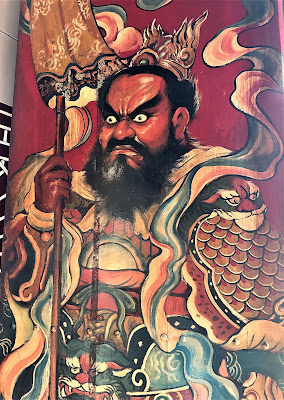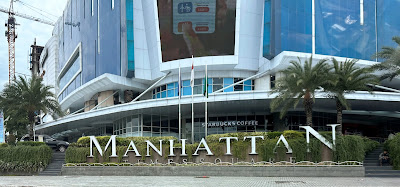July 1, 2023
After a 17-hour flight to Singapore, a 15-hour time change, and a full day on our feet, we really needed sleep, but we got up at 4:30 AM, pulled ourselves together and called a car, and made our way to the airport for a 7:00 AM flight to the city of Medan, located on the island of Sumatra in Indonesia. The flight itself was just 1 hour 5 minutes.
Arrival was complicated. We got in line at Passport control, only to be sent back to buy a 30-day "Visa on Arrival." In all our correspondence with the travel company and research online, this was not mentioned. The price was $35/person, and of course they required cash (no credit), and we had yet to visit an ATM in Indonesia to get some cash, so we had to dig out US dollars.
I had checked a bag, so we made a bathroom stop (apparently women are identified by their shopping bags here?) and then waited for my suitcase, hoping it wasn't one of the suitcases dangling artistically from the ceiling. I was happy to see it come rolling out on the conveyor belt.
The 30-room palace was built between 1887-1891 by Sultan Ma'mun Al Rashid Perkasa Alamyah. A "sultan" is a Muslim king or sovereign, and this one was in office from 1873-1924. Yellow, by the way, is the color of royalty in this part of the world.
This is not a bed. It is the inauguration throne.
Yeah, that looks a lot more comfortable than a wooden chair.
Here is a slightly older view of the same throne.
The current sultan was only 8 years old when he was installed in 2005. That is his portrait below. (His father died in a plane crash.) He is 26 years old now, and he still resides in the back of the palace when he is in Medan. Visitors can rent a royal costume and pose for photos at various locations throughout the palace.
We met our guide Ardian (like Adrian, but with dyslexia), who took us to four different ATMs in and around the airport, none of which worked for us. We felt just a little panicky. No worries, said Ardian, and on our way out of the city, we stopped at a not-very-official-looking money changer to convert our USD to Indonesian rupiahs. We had researched the exchange rate in advance, but it was a still shocking to get over 1.5 million rupiahs for just $100. (The exchange rate was 15,150 rupiah for $1 USD.)
For whatever reason, we struggled more with the mental math than usual when calculating the cost of things. We just couldn't make sense out of the fact that 100,000 rupiah (the largest denomination) equals $6.60.
The limits for many ATM's in Sumatra is 250,000 rupiahs, but you can withdraw three consecutive times, so I would get 750,000 rupiahs, or about $50, not realizing that I was paying between $6.50 and $7.50 for each of the three transactions. We've always gotten our foreign money from ATMs, as that is supposed to be the cheapest way to go, but that's not true if you can only withdraw $17 at a time! The further east we traveled, the more money we could withdraw at a time and the less burdensome those fees became. I guess the amount we could withdraw at one time from an ATM was a pretty good reflection of the economy of the area, with Sumatra being the poorest of all the places we went. We also found that most places in Sumatra wanted to be paid in cash, so using our VISA with no foreign transaction fees was not an option.
What we learned: If going to Indonesia, Sumatra in particular (and maybe Borneo as well), try to exchange USD for rupiahs in advance in the USA. On the other hand, once we got to tourist-friendly Bali, where we could withdraw 2,000,000 rupiah at a time (about $132), this was no longer an issue.
Ardian had planned two stops that were not on our itinerary in order to break up a long drive to our first destination. Our first stop was the Istana Maimoon (AKA Maimun), the royal palace of the Sultanate of Deli. "Istana" means "palace."
The interior combines elements of Islamic, Indian, and Malay architecture, as well as Spanish and Italian furniture and décor. There is a nice feline touch as well.
Did I mention that we had to remove our shoes? Also, we were limited to visiting only the front two rooms of the palace.
There is a round platform in front of the palace, strategically placed for optimal social media posts. Our guide Ardian loved to be in photos with us.
We got back on the road and drove through downtown Medan, the capital of Indonesia's North Sumatra province and its largest city with a population of 2.5 million.
The video above doesn't show how bad the traffic is. We would never rent a car in Indonesia. First, the steering wheel is on the right and the cars drive on the left, but the bigger issues are that 1) for all intents and purposes there are no lanes, and 2) motorcycles outnumber cars by at least 3 to 1 and they pretty much do what they want, including loading up whole families on one bike. It was very common to see small children squished between two people like this. Note also that very young girls are wearing head coverings, which we have not noticed in other Muslim countries.
Our next stop was the Gunung Timur Buddhist Temple. Ardian told us that 20% of the area's population is Buddhist, but Wikipedia says Sumatra is 90% Muslim and Buddhists are a small majority behind Protestant Christians and Hindus.
From the parking lot, it didn't look like much.
However, it was quite a bit more impressive from the other side. It was founded jointly by Medan's Taoist and Buddhist communities and was built in 1962.
In front of the entrance are two Chinese-style lions.
Another very fancy, very ornate lion helps guard the entrance. I love their ribbon necklaces.
Clearly, there is a lot going on here that I have absolutely no clue about.
But I can appreciate the obvious devotion represented by the all the glitz and glamor.
And there are some things that feel familiar. For example, this row of candles is not so different from the Catholic and Protestant tradition of lighting candles in churches.
And this appears to be an altar where a worshiper kneels on the red pillow in prayer.
More often than not, however, the images and their meanings are foreign to me.
Is it just me, or does this look like someone using a cell phone?
Deep inside the temple, I began to recognize the Buddha (I think). An offering is set before him on the table in the foreground. Most of the food offerings included a pineapple, which is considered a highly prized offering and acts as a symbol for happiness, wealth, and longevity.
This mural behind a pool was one of my favorite things in the temple.
As Siddhartha Gautama (Baby Buddha) walks, a lotus flower appears on the ground with each step:
Lord Buddha meditating and attaining enlightenment under a Bodhi tree:
The Buddha dies and attains Nirvana.
In contrast, these three fellas don't look they are anywhere close to Nirvana, but what do I know? Note the pineapple offering at the bottom left of the first picture.
. . . until we got closer. Not what I expected!
Weddings are huge events in Indonesia, and typically include a dowry, or a large amount of money or property paid by the groom to the family of the bride. The wedding itself can last for several days and usually involves a large number of family members.
Selamat Bahagia means "Happy Greetings."
We stopped at a restaurant named Cabe Hijo for lunch. It was mid-afternoon, and the place was not very crowded. We were pretty far from any tourist site, so all the other customers appeared to be locals. It was hot and muggy, and we were grateful for the large fans placed throughout the open room.
Not the Buddha, but someone else deep in meditation.
This dog also gets a pineapple offering. Do dogs like pineapple?
Well, we still had four hours of driving to do, none of it on nice U.S.-style highways, so we got back on the road.
Ardian was excited to point out this luxury hotel, and I couldn't figure out why . . .
He also pointed out these floral billboards we saw in almost every city. They are "Happy Wedding" greetings.
The waiters and waitresses were anxious to practice their English on us, and it was fun to see them in their matching outfits, including a red hijab or headcovering for the women. We noticed that almost all the women in Indonesia who wear a hijab have the "camel hump" addition in the back, which gives the impression of a vast amount of hair forming a bun but is really mostly artificial and made with sponges and clips. There is some argument among Muslims whether such a hump is "halal" or permissible, but apparently it is in Indonesia because they are the rule rather than the exception.
Like most tropical locales, Indonesia makes great fruit juices. These two weren't as good as others we had later. Bob ordered some kind of duck dish, and I ordered chicken and rice. Neither of them were very good. We gave them a 2 out of 5. But we were hungry, and they did the job.
After leaving the Buddhist temple, we had an excruciating four-hour drive, mostly on poorly maintained dirt roads full of rocks. We were in a small van, not a 4-wheel drive, and the bumping and rocking was my worst nightmare. By the time we arrived at our destination, I was feeling pretty green.
But there were fun times ahead.







.JPG)
.JPG)


.JPG)

.JPG)
.JPG)

.JPG)








.JPG)









.JPG)




.JPG)

.JPG)
.JPG)
.JPG)
.JPG)

.JPG)
.JPG)








.JPG)










.JPG)
.JPG)
.JPG)
(Bob) Medan looked like a rough place. If the two places we visited are the best it has to offer, I appreciate all the more the trip into the interior. The duck I had at the restaurant could have been the worst meal I had in Indonesia.
ReplyDelete